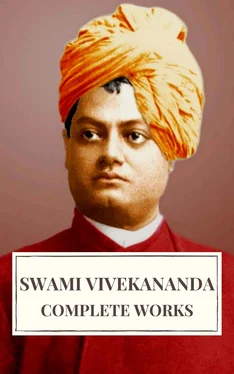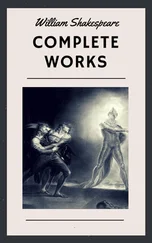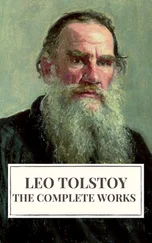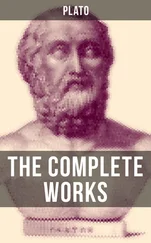Again, in the very same meditation, when one struggles to take the elements out of time and space, and think of them as they are, it is called Nirvitarka, without question. When the meditation goes a step higher, and takes the Tanmatras as its object, and thinks of them as in time and space, it is called Savichâra, with discrimination; and when in the same meditation one eliminates time and space, and thinks of the fine elements as they are, it is called Nirvichâra, without discrimination. The next step is when the elements are given up, both gross and fine, and the object of meditation is the interior organ, the thinking organ. When the thinking organ is thought of as bereft of the qualities of activity and dullness, it is then called Sânanda, the blissful Samadhi. When the mind itself is the object of meditation, when meditation becomes very ripe and concentrated, when all ideas of the gross and fine materials are given up, when the Sattva state only of the Ego remains, but differentiated from all other objects, it is called Sâsmita Samadhi. The man who has attained to this has attained to what is called in the Vedas “bereft of body”. He can think of himself as without his gross body; but he will have to think of himself as with a fine body. Those that in this state get merged in nature without attaining the goal are called Prakritilayas, but those who do not stop even there reach the goal, which is freedom.

18. There is another Samadhi which is attained by the constant practice of cessation of all mental activity, in which the Chitta retains only the unmanifested impressions.
This is the perfect superconscious Asamprajnata Samadhi, the state which gives us freedom. The first state does not give us freedom, does not liberate the soul. A man may attain to all powers, and yet fall again. There is no safeguard until the soul goes beyond nature. It is very difficult to do so, although the method seems easy. The method is to meditate on the mind itself, and whenever thought comes, to strike it down, allowing no thought to come into the mind, thus making it an entire vacuum. When we can really do this, that very moment we shall attain liberation. When persons without training and preparation try to make their minds vacant, they are likely to succeed only in covering themselves with Tamas, the material of ignorance, which makes the mind dull and stupid, and leads them to think that they are making a vacuum of the mind. To be able to really do that is to manifest the greatest strength, the highest control. When this state, Asamprajnata, superconsciousness, is reached, the Samadhi becomes seedless. What is meant by that? In a concentration where there is consciousness, where the mind succeeds only in quelling the waves in the Chitta and holding them down, the waves remain in the form of tendencies. These tendencies (or seeds) become waves again, when the time comes. But when you have destroyed all these tendencies, almost destroyed the mind, then the Samadhi becomes seedless; there are no more seeds in the mind out of which to manufacture again and again this plant of life, this ceaseless round of birth and death.
You may ask, what state would that be in which there is no mind, there is no knowledge? What we call knowledge is a lower state than the one beyond knowledge. You must always bear in mind that the extremes look very much alike. If a very low vibration of ether is taken as darkness, an intermediate state as light, very high vibration will be darkness again. Similarly, ignorance is the lowest state, knowledge is the middle state, and beyond knowledge is the highest state, the two extremes of which seem the same. Knowledge itself is a manufactured something, a combination; it is not reality.
What is the result of constant practice of this higher concentration? All old tendencies of restlessness and dullness will be destroyed, as well as the tendencies of goodness too. The case is similar to that of the chemicals used to take the dirt and alloy off gold. When the ore is smelted down, the dross is burnt along with the chemicals. So this constant controlling power will stop the previous bad tendencies, and eventually, the good ones also. Those good and evil tendencies will suppress each other, leaving alone the Soul, in its own splendour untrammelled by either good or bad, the omnipresent, omnipotent, and omniscient. Then the man will know that he had neither birth nor death, nor need for heaven or earth. He will know that he neither came nor went, it was nature which was moving, and that movement was reflected upon the soul. The form of the light reflected by the glass upon the wall moves, and the wall foolishly thinks it is moving. So with all of us; it is the Chitta constantly moving making itself into various forms, and we think that we are these various forms. All these delusions will vanish. When that free Soul will command — not pray or beg, but command — then whatever It desires will be immediately fulfilled; whatever It wants It will be able to do. According to the Sankhya philosophy, there is no God. It says that there can be no God of this universe, because if there were one, He must be a soul, and a soul must be either bound or free. How can the soul that is bound by nature, or controlled by nature, create? It is itself a slave. On the other hand, why should the Soul that is free create and manipulate all these things? It has no desires, so it cannot have any need to create. Secondly, it says the theory of God is an unnecessary one; nature explains all. What is the use of any God? But Kapila teaches that there are many souls, who, though nearly attaining perfection, fall short because they cannot perfectly renounce all powers. Their minds for a time merge in nature, to re-emerge as its masters. Such gods there are. We shall all become such gods, and, according to the Sankhyas, the God spoken of in the Vedas really means one of these free souls. Beyond them there is not an eternally free and blessed Creator of the universe. On the other hand, the Yogis say, “Not so, there is a God; there is one Soul separate from all other souls, and He is the eternal Master of all creation, the ever free, the Teacher of all teachers.” The Yogis admit that those whom the Sankhyas call “the merged in nature” also exist. They are Yogis who have fallen short of perfection, and though, for a time, debarred from attaining the goal, remain as rulers of parts of the universe.

19. (This Samadhi when not followed by extreme non-attachment) becomes the cause of the re-manifestation of the gods and of those that become merged in nature.
The gods in the Indian systems of philosophy represent certain high offices which are filled successively by various souls. But none of them is perfect.

20. To others (this Samadhi) comes through faith, energy, memory, concentration, and discrimination of the real.
These are they who do not want the position of gods or even that of rulers of cycles. They attain to liberation.

21. Success is speedy for the extremely energetic.

22. The success of Yogis differs according as the means they adopt are mild, medium, or intense.
Читать дальше

















